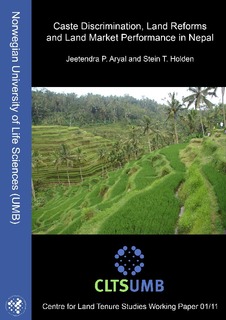| dc.contributor.author | Aryal, Jeetendra P. | |
| dc.contributor.author | Holden, Stein Terje | |
| dc.coverage.spatial | Nepal | nb_NO |
| dc.date.accessioned | 2018-01-09T12:23:13Z | |
| dc.date.available | 2018-01-09T12:23:13Z | |
| dc.date.issued | 2011 | |
| dc.identifier.uri | http://hdl.handle.net/11250/2476407 | |
| dc.description.abstract | The caste system is an intricate part of the institutional structure as well as class formation, political instability and conflicts in Nepal. The most severely discriminated group in the caste system is the Dalits, the so-called “untouchables”. Dalits faced religious, occupational and even, territorial discrimination. They were traditionally excluded from receiving education, using public resources, and had no rights to own land (Dahal 1995; CHRGJ 2005; Haug, Aasland and Dahal 2009). | nb_NO |
| dc.language.iso | eng | nb_NO |
| dc.publisher | Norwegian University of Life Sciences, Ås | nb_NO |
| dc.relation.ispartofseries | CLTS Working Paper;2011:01 | |
| dc.rights | Attribution-NonCommercial-NoDerivatives 4.0 Internasjonal | * |
| dc.rights.uri | http://creativecommons.org/licenses/by-nc-nd/4.0/deed.no | * |
| dc.title | Caste discrimination, land reforms and land market performance in Nepal | nb_NO |
| dc.type | Working paper | nb_NO |
| dc.subject.keyword | Land reform | |
| dc.subject.keyword | Land Markets | |
| dc.subject.keyword | Land distribution | |
| dc.subject.keyword | Caste system | |

